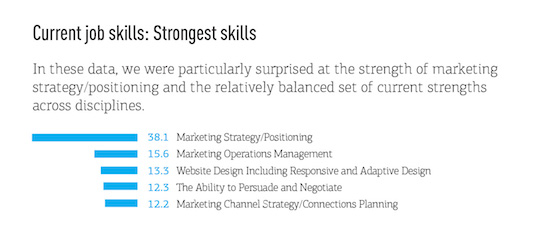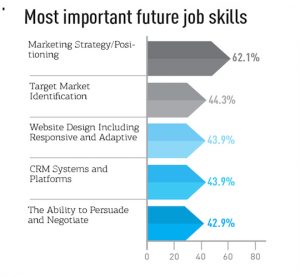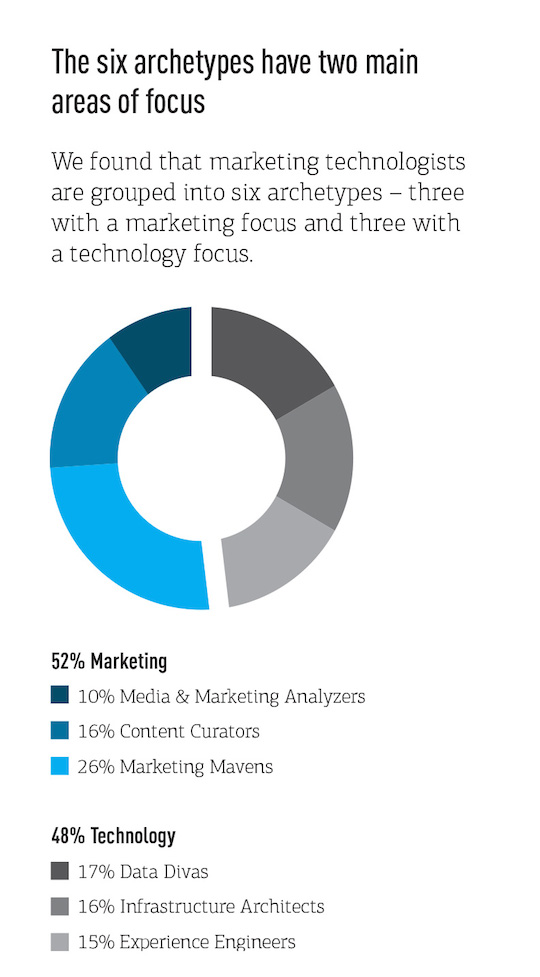Analysing the chief marketing technologist
Share
 Sheldon Monteiro, Hilding Anderson and Scott Tang analyse research conducted by their firm, SapientNitro, into the rise of the ‘chief marketing technologist’ – what the new breed looks like, what that means for education, and implications for the generalist-specialist status quo.
Sheldon Monteiro, Hilding Anderson and Scott Tang analyse research conducted by their firm, SapientNitro, into the rise of the ‘chief marketing technologist’ – what the new breed looks like, what that means for education, and implications for the generalist-specialist status quo.
It’s yesterday’s news that marketing and technology have become inextricably intertwined. Tectonic forces, enabled by technology, have fuelled more disruption and competition for customer attention in the last five years than corporations experienced in the 50 years prior.
It’s no surprise then that Harvard Business Review recently joined the chorus and profiled the ‘Rise of the Chief Marketing Technologist (CMT)’ – a new type of executive responsible for bringing marketing and technology together.
Despite the excitement around marketing technology and the CMT role, the ambiguity as to who these individuals are, the skills they possess, and where they sit organisationally has led to considerable confusion.
To help us shed more light on these issues, SapientNitro conducted a first-of-its-kind study of marketing technologists’ skills, career paths, attitudes, and behaviours. For the first time, we have been able to ‘x-ray’ the professional marketing technologist. And the results are striking.
Today’s marketing technologists cluster into six distinct archetypes, and they are not equivalent or interchangeable. Of the six archetypes, three are focused on technology and three are focused on marketing.
The six archetypes have two main areas of focus:
Marketing Mavens (26%): With marketing skills emphasised over technology, mavens specialise in building marketing programs using expertise in marketing strategy, strategic positioning, and promotion.
Data Divas (17%): Divas are skilled in marketing operations management, customer relationship management (CRM), data science, analytics, and modelling. They know how to acquire, integrate, and make data perform.
Content Curators (16%): Storytellers. Message crafters. Marketing strategists. Content management platform experts. This type exercises considerable knowledge of content marketing and related technologies to direct communications-oriented marketing.
Infrastructure Architects (16%): Enterprise-level technology chops define this archetype, but they are also business consultants and bring a high-level understanding of a company’s marketing initiatives.
Experience Engineers (15%): One foot in technology and the other in experience. They are experts in cutting-edge technology: from ecommerce to front-end technology and mobility.
Media & Marketing Analysers (10%): This archetype specialises in research, consumer insights, and strategic planning. Members think strategically about segmentation and connections planning.
~
The emergence of these archetypes may represent specialisation within the profession, often seen in mature fields such as medicine or engineering.
However, we doubt it.
More likely, the skill gaps we found indicate that the archetypes are emerging through a Darwinian selection process as individuals who may not meet the full job specifications are promoted into this new role.
So what were the key findings from the study? Overall:
- Marketing technologists report to marketing,
- today’s practitioners are learning technology on the job,
- current and desired job skills are balanced between marketing, technology, and business,
- there are alarming deficiencies in current skill sets,
- the gap between marketing and technology is real, even for marketing technologists, and
- while 69.2% report to the C-suite, just 8.6% of marketing technologists reported to the CIO, with the majority reporting to the CMO or CEO/President. Our findings matched other recent industry surveys in this regard.
In our view, this reporting bias could explain the surprising underweighting of science, technology, engineering, and math (STEM) academic backgrounds in the population.
Our hypothesis: Marketers and business leaders are promoting from within their own departmental ranks and backgrounds. This is understandable, but executives should consider where pure-play digital firms – who are setting the pace of today’s disruption – are sourcing their talent, and then consider proactive skills development to level up existing talent, or increase the diversity of their talent sourcing, for instance, by overweighting IT and business analytics capabilities.
Today, marketing technologists are strongest in core marketing skills, and only 26% have STEM degrees. Additionally, nearly half of the respondents reported that their prior job was managing technology or programming – often in a marketing context – providing the job environment for developing technical skills. We believe the lack of hybrid academic programs is forcing talent to train on the job.
The implication? Rudimentary preparation in computer science fundamentals, systems and algorithmic thinking, statistics, and data science may be glossed over or completely skipped, which will undoubtedly impair job effectiveness.
Interestingly, technology-oriented marketing technologists are 20% more likely to be the ‘primary’ or ‘chief’ marketing technology officer, indicating that greater responsibilities are awarded to those with technical proficiency.
The top five skills that respondents report possessing are marketing strategy and positioning, marketing operations management, website design, the ability to persuade and negotiate, and marketing channel strategy/connections planning. Perhaps attributable in part to confirmation bias (the tendency to search for or interpret information in a way that confirms one’s preconceptions), three of these were also featured in the five skills that respondents said are most important to the future of marketing.

Regardless, we are delighted to observe a balance between marketing, technology, and business domains, all three of which are essential for success in the role, in our view.
 Advertising technology, system performance and resiliency, and several omnichannel-enabling technologies are featured in the bottom ten of self-assessed current skills, with information security coming in dead last.
Advertising technology, system performance and resiliency, and several omnichannel-enabling technologies are featured in the bottom ten of self-assessed current skills, with information security coming in dead last.
This lack of skills is of huge concern in light of recent, massive security breaches across industries, the extreme scale at which digital businesses must operate during periods of high demand, and the ever increasing requirements for brands to imagine and deliver immersive and pervasive experiences.
While 94% believe that marketing and IT skills could be combined in a single person, respondents identified a stark polarity between marketing and systems integration expertise.
Most technology archetypes are less likely to describe themselves as ‘marketing experts’ and marketing archetypes don’t think of themselves as ‘systems integrators.’
This subtle indication of how respondents described who they are may be indicative of the culture gap that must be overcome for the role to attain its highest potential. In our view, the CMT role must straddle both functions as a native, rather than majoring in one and minoring in the other.
~
The full version of the report ‘Analysing the Chief Marketing Technologist’ is available for subscribers to Marketing Mag’s Newsletter – download it here.
~
Sheldon Monteiro is global chief technology officer, Hilding Anderson is director research and insights and Scott Tang is head of global consumer and industry research, at SapientNitro.
















